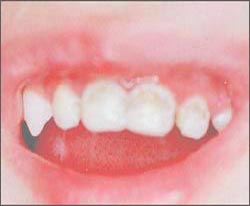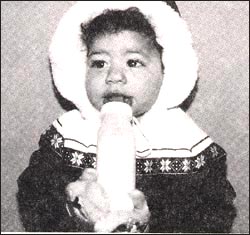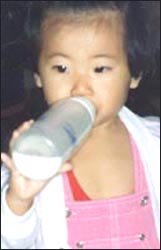젖병(우유병)과 이 건강(치아 건강), Nursing bottle and teeth

사진 25. 18개월 된 유아의 치아에 생긴 우유병 1도 충치
Copyright ⓒ 2011 John Sangwon Lee, M.D., FAAP
- 영유아들이 인공영양이나 당질이 든 과일 주스 등 액체 음식물을 우유병(젖병)에 넣어 밤낮 가리지 않고 빨아먹을 때 충치가 생길 수 있다.
- 이렇게 주스 등 당분 액체 음식물이 든 우유병을 아무 때나 빨아 생긴 충치를 우유병에 의한 충치(젖병 충치/우유병) 또 우유병 우식증이라고 한다.
- 일반적으로 영아들은 생후 6~9개월경 한두 개의 젖니가 난다.
- 빠르면 생후 4개월 또는 4개월 전에도 첫 젖니가 난다.
- 영아들이나 유아들이 사랑해 달라고 울거나 칭얼댈 때 영유아를 안아 주지도 않고, 같이 놀아 주지도 않고, 달래 주지도 않고 사랑해 주지 않고 아기의 입에 우유병을 물려주는 부모들도 가끔 있다.
- 영유아가 잠 잘 때마다 잠자기 전 인공영양이나 당질 성분이 든 주스, 또는 그 외 액체 음료수를 우유병에 담아 우유병 젖꼭지를 입에 물린 채 재우는 경우도 있다.
- 이 때 인공영양이나 액체 음료수에 든 당질이 젖니의 에나멜에 묻어 심한 충치가 생길 수 있다.
- 당질이 든 음식물을 넣은 우유병을 낮에도 빨아먹을 때도 음식물 찌꺼기가 이에 묻어 충치가 생길 수 있으나, 낮에는 침이 입안으로 계속 많이 분비되어 낮에 우유병을 계속 빨아도 충치가 덜 생긴다.
- 많이 활동하는 낮보다 밤에 잠잘 때는 침이 덜 난다. 그 때문에 인공영양이나 우유 또는 단 액체 음료수를 넣은 우유병을 물고자면 충치가 더 잘 생길 수 있다.

사진 26. 우유병을 항상 빨면 충치가 생기기 쉽다.
Copyright ⓒ 2011 John Sangwon Lee, M.D., FAAP

사진 27. 우유병을 항상 빠는 버릇은 여러모로 좋지 않다.
Copyright ⓒ 2011 John Sangwon Lee, M.D,, FAAP
우유병에 의한 충치(젖병 충치/우유병 우식증) 생기지 않게 예방 방법
① 생후 6개월 때까지 영아들에게 인공영양을 먹일 때 매 3~4시간마다 한 번에 15~30분 동안 먹인다. 그 외 시간에는 가능한 한 인공영양 우유병을 빨게 해서는 안 된다.
② 인공영양이나 당질이 들어 있는 주스나 다른 종류의 음료수를 담은 우유병을 아무 때나 빨도록 해서는 안 된다. 특히 잠잘 때 우유병을 빨면서 재워서는 안 된다.
③ 잠잘 때 우유병을 빨지 않으면 자지 않는 영유아들이 가끔 있다. 이런 때는 인공영양이나 당질이 든 음료수 대신 맹물을 우유병에 넣어 빨게 하든지, 노리개젖꼭지를 빨게 할 수 있다.
④ 당질이 든 음료수나 인공영양이 든 우유병을 자주 빨아먹을 때는 충치가 생기는지 조심스럽게 관찰한다.
⑤ 음식물 찌꺼기가 이에 묻으면 젖은 물수건으로 살짝 훔쳐낸다.
⑥ 생후 2세 6개월부터 치과에서 정기적으로 치아 검진을 해 주고 필요에 따라 치료한다.
⑦ 안전사고나, 심한 운동, 장난하다가 치아 타박상이 생길 수 있다. 이때 이가 부러지거나 빠지거나, 이뿌리가 본래 있던 자리에서 옆자리로 또는 앞뒤 쪽으로 조금 밀리어 갈 수 있고 흔들일 수 있다.
치아 까짐(치아 미란) Dental erosion
- 치아 경조직이 화학 작용으로 인해 점차로 비가역적으로 상실 되는 현상을 치아 까짐이라 한다.
- 탄산 음료수, 산성 음료수, 산성 음식물, 만성 구토 , 위식도 역류 등으로 생길 수 있다.
- 치아 예민 감각, 치통, 치아 상실 등이 생길 수 있다.
- 원인을 제거 해 치료 한다. 소스:AAP News June 2011
감소된다는 연구 결과가 나왔다” (Contemporary Pediatrics 6/19/3014).
Copyright ⓒ 2012 John Sangwon Lee, MD, FAAP
Nursing bottle and teeth

Photo 25. Milk bottle first degree cavities on teeth of an 18-month-old infant Copyright ⓒ 2011 John Sangwon Lee, M.D., FAAP
• Tooth decay can occur when infants and young children put liquid food, such as artificial nutrition or fruit juice containing sugar, into a milk bottle and suck it day or night.
• Caries caused by sucking a milk bottle containing juice or other sugary liquid food at any time are called caries caused by a milk bottle (baby bottle caries/milk bottle) or milk bottle caries.
• Typically, infants have one or two milk teeth around 6 to 9 months of age.
• The first teething occurs as early as 4 months or even before 4 months of age.
• Parents sometimes put a bottle of milk in their baby’s mouth when their infants or toddlers cry or cry for love, without hugging them, playing with them, comforting them or loving them.
• In some cases, when infants and young children go to sleep, they put artificial nutrition, sugar-containing juices, or other liquid beverages in a milk bottle and put the bottle nipple in their mouth before going to sleep.
• At this time, sugars in artificial nutrition or liquid drinks may stick to the enamel of milk teeth and cause severe tooth decay.
• Even if you suck a milk bottle with sugar in it during the day, food waste may stick to your teeth and cause tooth decay.
• Sleep less at night than during the day when you are most active. For that reason, biting into a bottle of artificial nutrition or milk or sweet liquid beverages can increase the risk of tooth decay.

Photo 26. If you always suck the milk bottle, it is easy to get cavities. Copyright ⓒ 2011 John Sangwon Lee, M.D., FAAP

Photo 27. The habit of always washing a bottle of milk is not good in many ways. Copyright ⓒ 2011 John Sangwon Lee, M.D., FAAP
How to prevent caries caused by milk bottles (baby bottle caries/milk bottle caries)
① When feeding infants up to 6 months of age with artificial nutrition, feed them every 3 to 4 hours for 15 to 30 minutes at a time. At other times, if possible, bottles of artificial nutrition should not be sucked.
② Milk bottles containing juices or other types of beverages containing artificial nutrition or sugar must not be sucked at any time. In particular, do not put the milk bottle to sleep while sucking it.
③ There are some infants and toddlers who do not sleep unless they suck the bottle while sleeping. In this case, instead of artificial nutrition or sugar-containing drinks, you can put fresh water in a milk bottle to suck, or you can suck a soother.
④ When frequently sucking sugar-containing beverages or milk bottles containing artificial nutrition, carefully observe whether tooth decay occurs.
⑤ If food residue gets on your teeth, gently wipe it off with a wet towel.
⑥ From the age of 2 years and 6 months, regular dental checkups are performed at the dentist, and treatment is provided as necessary.
⑦ Tooth bruises may occur during safety accidents, intense exercise, or playing games. At this time, the tooth may break or fall out, or the tooth root may be moved from its original position to the side or back and forth slightly and may shake.
Dental erosion
• The gradual and irreversible loss of tooth hard tissue due to chemical action is called tooth scraping.
• It can be caused by carbonated drinks, acidic drinks, acidic foods, chronic vomiting, and gastroesophageal reflux.
• Tooth sensitivity, toothache, and tooth loss may occur.
• Remove the cause and treat it. Source: AAP News June 2011 Studies have shown that it decreases” (Contemporary Pediatrics 6/19/3014). Copyright ⓒ 2012 John Sangwon Lee, MD, FAAP
출처 및 참조 문헌 Sources and references
- NelsonTextbook of Pediatrics 22ND Ed
- The Harriet Lane Handbook 22ND Ed
- Growth and development of the children
- Red Book 32nd Ed 2021-2024
- Neonatal Resuscitation, American Academy of Pediatrics
-
Oral Health The Pediatric Clinics of North America, Stuart D.Josell
-
Pediatric Oral Health Stuart Jose
-
Ann L. Griffen, DDS, MS
-
Atlas Pediatric Physical Diagnosis Frank A Oski
- www.drleepediatrics.com 제1권 소아청소년 응급 의료
- www.drleepediatrics.com 제2권 소아청소년 예방
- www.drleepediatrics.com 제3권 소아청소년 성장 발육 육아
- www.drleepediatrics.com 제4권 모유,모유수유, 이유
- www.drleepediatrics.com 제5권 인공영양, 우유, 이유식, 비타민, 미네랄, 단백질, 탄수화물, 지방
- www.drleepediatrics.com 제6권 신생아 성장 발육 육아 질병
- www.drleepediatrics.com제7권 소아청소년 감염병
- www.drleepediatrics.com제8권 소아청소년 호흡기 질환
- www.drleepediatrics.com제9권 소아청소년 소화기 질환
- www.drleepediatrics.com제10권. 소아청소년 신장 비뇨 생식기 질환
- www.drleepediatrics.com제11권. 소아청소년 심장 혈관계 질환
- www.drleepediatrics.com제12권. 소아청소년 신경 정신 질환, 행동 수면 문제
- www.drleepediatrics.com제13권. 소아청소년 혈액, 림프, 종양 질환
- www.drleepediatrics.com제14권. 소아청소년 내분비, 유전, 염색체, 대사, 희귀병
- www.drleepediatrics.com제15권. 소아청소년 알레르기, 자가 면역질환
- www.drleepediatrics.com제16권. 소아청소년 정형외과 질환
- www.drleepediatrics.com제17권. 소아청소년 피부 질환
- www.drleepediatrics.com제18권. 소아청소년 이비인후(귀 코 인두 후두) 질환
- www.drleepediatrics.com제19권. 소아청소년 안과 (눈)질환
- www.drleepediatrics.com 제20권 소아청소년 이 (치아)질환
- www.drleepediatrics.com 제21권 소아청소년 가정 학교 간호
- www.drleepediatrics.com 제22권 아들 딸 이렇게 사랑해 키우세요
- www.drleepediatrics.com 제23권 사춘기 아이들의 성장 발육 질병
- www.drleepediatrics.com 제24권 소아청소년 성교육
- www.drleepediatrics.com 제25권 임신, 분만, 출산, 신생아 돌보기
- Red book 29th-31st edition 2021
- Nelson Text Book of Pediatrics 19th- 21st Edition
- The Johns Hopkins Hospital, The Harriet Lane Handbook, 22nd edition
- 응급환자관리 정담미디어
- Pediatric Nutritional Handbook American Academy of Pediatrics
- 소아가정간호백과–부모도 반의사가 되어야 한다, 이상원 저
- The pregnancy Bible. By Joan stone, MD. Keith Eddleman, MD
- Neonatology Jeffrey J. Pomerance, C. Joan Richardson
- Preparation for Birth. Beverly Savage and Dianna Smith
- 임신에서 신생아 돌보기까지. 이상원
- Breastfeeding. by Ruth Lawrence and Robert Lawrence
- Sources and references on Growth, Development, Cares, and Diseases of Newborn Infants
- Emergency Medical Service for Children, By Ross Lab. May 1989. p.10
- Emergency care, Harvey Grant and Robert Murray
- Emergency Care Transportation of Sick and Injured American Academy of Orthopaedic Surgeons
- Emergency Pediatrics A Guide to Ambulatory Care, Roger M. Barkin, Peter Rosen
- Quick Reference To Pediatric Emergencies, Delmer J. Pascoe, M.D., Moses Grossman, M.D. with 26 contributors
- Neonatal resuscitation Ameican academy of pediatrics
- Pediatric Nutritional Handbook American Academy of Pediatrics
- Pediatric Resuscitation Pediatric Clinics of North America, Stephen M. Schexnayder, M.D.
-
Pediatric Critical Care, Pediatric Clinics of North America, James P. Orlowski, M.D.
-
Preparation for Birth. Beverly Savage and Dianna Smith
-
Infectious disease of children, Saul Krugman, Samuel L Katz, Ann A.
-
Emergency Care Transportation of Sick and Injured American Academy of Orthopaedic Surgeons
-
Emergency Pediatrics A Guide to Ambulatory Care, Roger M. Barkin, Peter Rosen
-
Gray’s Anatomy
-
제19권 소아청소년 안과 질환 참조문헌 및 출처
- Habilitation of The handicapped Child, The Pediatric Clinics of North America, Robert H Haslam, MD.,
-
Pediatric Ophthalmology, The Pediatric Clinics of North America, Leonard B. Nelson, M.D.
-
Pediatric Ophthalmology, The Pediatric Clinics of North America, Lois J. Martyn, M.D.
-
Pediatric Ophthalmology, Edited by Robison D. Harley, M.D.
-
The Pediatric Clinics of North America, David Tunkel, MD., Kenneth MD Grundfast, MD
Copyright ⓒ 2014 John Sangwon Lee, MD., FAAP
“부모도 반의사가 되어야 한다”-내용은 여러분들의 의사로부터 얻은 정보와 진료를 대신할 수 없습니다.
“The information contained in this publication should not be used as a substitute for the medical care and advice of your doctor. There may be variations in treatment that your doctor may recommend based on individual facts and circumstances.
“Parental education is the best medicine.